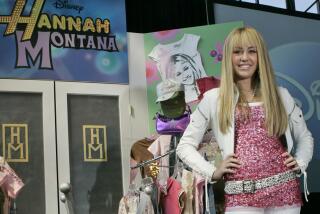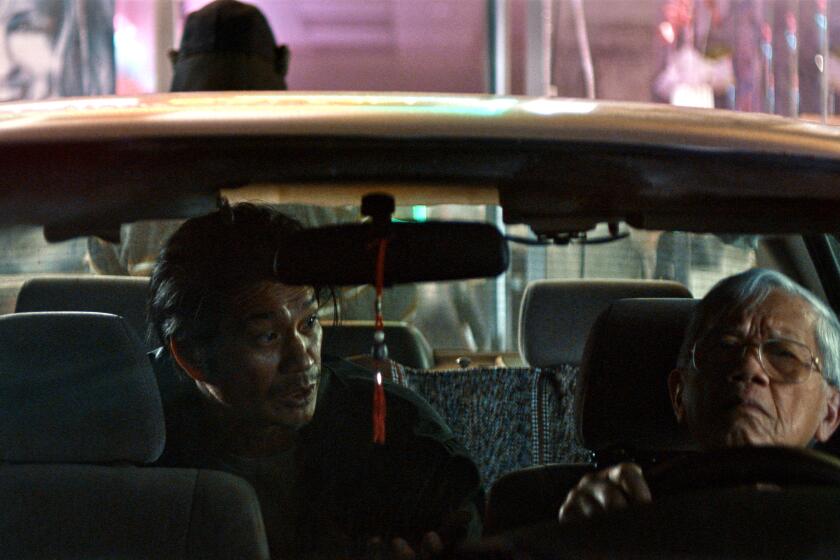Disney’s ‘Treasure Planet’ an Adventure in Losing Money
- Share via
This is no Cinderella story.
For nearly two decades, Walt Disney Co. filmmakers Ron Clements and John Musker dreamed of making an animated movie based on Robert Louis Stevenson’s classic coming-of-age novel “Treasure Island.” In their version, the action would unfold in outer space.
Even though the pair would emerge over time as two of the studio’s hottest director-producers, with such hits as “The Little Mermaid,” “Aladdin” and “Hercules,” the studio kept rejecting the pitch and shelving the project, saying it lacked fairy-tale magic.
But the two men persevered, refusing to let their dream die at the hands of disbelievers. They even outlasted the biggest naysayer of them all, studio Chairman Jeffrey Katzenberg, who was fired in 1994. So with the backing of Vice Chairman Roy Disney himself -- and a special contract provision -- the duo finally co-wrote, directed and produced “Treasure Planet.”
Last weekend it landed -- with a thud.
Far from being one of the “cinematic treasures” of the holiday season Disney promised in its promotional materials, the movie recorded a weak five-day gross of $16.6 million. The early financial results were so bad that Disney this week took the extraordinary step of lowering its annual earnings by tens of millions of dollars.
“Treasure Planet” -- which cost an estimated $180 million to make and market -- is expected to be the biggest money loser in the history of Disney animation. If that’s not bad enough, the flop has fueled continuing concerns among some investors and analysts that Disney’s storied animation division has lost its once-infallible touch.
Publicly, Disney executives are putting up a brave front amid the fallout. They say the movie was received well by test audiences and was hurt by stiff box-office competition from such family-oriented fare as “Harry Potter and the Chamber of Secrets” and Disney’s own “The Santa Clause 2.”
Even so, studio Chairman Richard Cook said the film’s failure had forced the studio to look inward.
“In our own self-criticism,” he said, “maybe we didn’t do a good enough job to entice an audience to want to come. Maybe we were too serious and earnest in the marketing -- that’s what we’re questioning.”
Clements and Musker, who are said to be devastated by the public’s rejection of their quixotic vision, declined to comment.
Unlike the usual stuff of Hollywood legends, in which labors of love blossom into multimillion-dollar hits -- think “My Big Fat Greek Wedding” -- the failure of “Treasure Planet” shows the perils of pursuing pet projects at all costs.
The movie business is, of course, always hit-and-miss. But in this case, there was trouble in the stars nearly from the start. The project was repeatedly pushed aside by other films and sidelined by concerns that the script was not compelling. At the company’s highest levels, clashes broke out over whether the movie should be made.
Even after millions had been spent on the production, Disney Chief Executive Michael Eisner reportedly expressed concerns when he viewed an early cut a year ago. But by then it was too late to change course.
The idea for “Treasure Planet” dates back 17 years. At the time, Disney’s feature animation division held a “gong show” of sorts to scout for new ideas. One of the first pitched by Clements was “Treasure Island in Space,” according to the movie’s press notes. He brought aboard collaborator Musker, with whom he wrote and directed the 1986 animated movie “The Great Mouse Detective.”
Although the Treasure Island project was enthusiastically embraced, Disney had something else in mind for the duo, “The Little Mermaid,” which Clements had also pitched. The film, released in 1989, was a huge success, ushering in a revival of animation at Disney.
But amid all the hoopla, Clements and Musker kept their focus and began sketching out their other idea, now called “Treasure Planet.” Once again, they were drafted to write and direct another Disney priority, “Aladdin,” which would become an even bigger draw in 1992.
With each successive hit, the pair’s stature grew, giving them what they hoped would be the opening to push through “Treasure Planet.” Now they had a script in hand and appeared to be gaining momentum when history repeated itself.
This time the movie was “Hercules.” Although the partners were gaining power for the renowned wit and style they brought to their undertakings, the idea closest to their heart did not capture the imagination of the man at the top of the studio, Katzenberg.
“He hated the idea,” said a former Disney executive familiar with the project’s history.
To begin with, the executive said, Katzenberg did not like the film’s concept. He thought it was simply a bad idea to take a classic adventure tale of a young boy’s coming of age and place it in space.
When Katzenberg halted the project, Clements and Musker were infuriated. Sources said they went to Roy Disney. He backed the filmmakers and made his wishes known to Eisner, who in turn agreed that the studio should make the movie.
Now it was Katzenberg who was livid, only complicating the bad feelings that had been developing between him and Eisner on a number of fronts, sources inside and outside the company say. Before long, Katzenberg was fired and began forming rival studio DreamWorks SKG.
Katzenberg, Eisner and Roy Disney declined to comment.
With Katzenberg out of the way, the project accelerated with a script Clements and Musker wrote with Rob Edwards.
Clements and Musker remained so passionate about and protective of their project that it became part of their 1995 negotiations to extend their contract with the studio for seven years. The contract stipulated that after fulfilling their “Hercules” commitment, the two were guaranteed the right to make “Treasure Planet” or another project mutually agreed upon.
But the journey to the screen would face new obstacles and concerns.
Long before its release, questions were being raised inside the studio about whether the film would take off with audiences. One of the biggest concerns centered on lead character Jim Hawkins. The troubled teenager seemed too harsh and brooding. Meanwhile, the second and third acts of the movie were thought to be flat and emotionless. Even Eisner, who had green-lighted the project, was said to be concerned about the characters and plot.
Fixes were suggested and made, including making the lead character more likable and sympathetic.
As the debut neared, Disney launched a marketing campaign that even by the studio’s own admission was surprisingly unmemorable, failing to entice moviegoers.
“In our marketing maybe we should have stressed other elements to make it fun and exciting,” studio chief Cook said.
Questions also are being raised about the timing of the movie’s release -- and why it would be pitted against films vying for the same family audience. Despite the competition, Cook said, “there was plenty of business out there -- we just didn’t get it.”
In reality, the studio had no choice. Under a promotional deal with its longtime partner McDonald’s Corp., the studio was locked into the Nov. 27 release date a year ago.
When the movie hit the theaters, executives throughout the Disney could only cringe. It could not have come at a worse time.
The company’s ailing ABC television network has begun to show signs of life after steep ratings slides. The studio’s last animated release, “Lilo & Stitch,” was a success this summer with children and grown-ups alike, proving that Disney still had some magic, even if people weren’t flocking to its theme parks.
For his part, Roy Conli, who served as a producer on the movie, is holding out hope that audiences will discover it: “This has always been a movie driven by the passion of the artists, the directors and myself, and the team is hoping it has legs.”
More to Read
The biggest entertainment stories
Get our big stories about Hollywood, film, television, music, arts, culture and more right in your inbox as soon as they publish.
You may occasionally receive promotional content from the Los Angeles Times.











